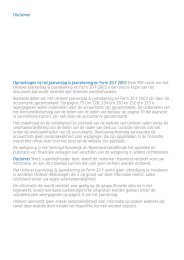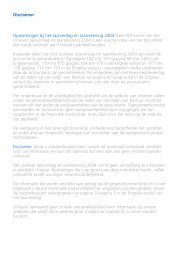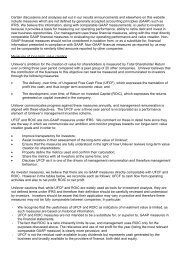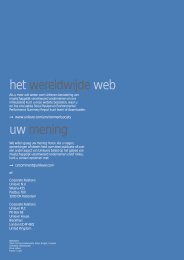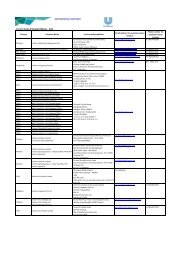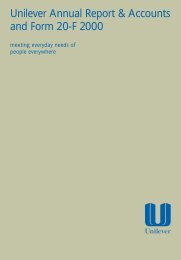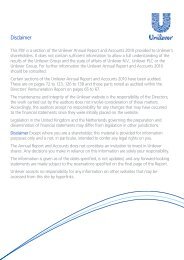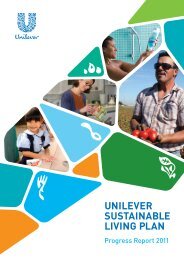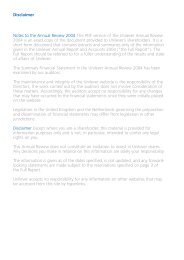Meeting everyday needs of people everywhere - Unilever
Meeting everyday needs of people everywhere - Unilever
Meeting everyday needs of people everywhere - Unilever
You also want an ePaper? Increase the reach of your titles
YUMPU automatically turns print PDFs into web optimized ePapers that Google loves.
64 <strong>Unilever</strong> Annual Report on Form 20-F 1999 Financial Statements<br />
<strong>Unilever</strong> Group Accounting information and policies<br />
On disposal <strong>of</strong> a business acquired prior to 1 January<br />
1998, purchased goodwill written <strong>of</strong>f on acquisition is<br />
reinstated in arriving at the pr<strong>of</strong>it or loss on disposal.<br />
Tangible fixed assets<br />
Tangible fixed assets are stated at cost less depreciation.<br />
Depreciation is provided on a straight-line basis at<br />
percentages <strong>of</strong> cost based on the expected average useful<br />
lives <strong>of</strong> the assets. Estimated useful lives by major class <strong>of</strong><br />
assets are as follows:<br />
Freehold buildings 33-40 years<br />
(no depreciation on freehold land)<br />
Leasehold land and buildings *33-40 years<br />
Plant and equipment 3-20 years<br />
Motor vehicles 3-6 years<br />
*or life <strong>of</strong> lease if less than 33 years<br />
Current cost information is given in note 9 on page 74.<br />
Fixed investments<br />
Joint ventures are undertakings in which the Group has<br />
a long-term participating interest and which are jointly<br />
controlled by the Group and one or more other parties.<br />
Associated companies are undertakings in which the<br />
Group has a participating interest and is able to exercise<br />
significant influence.<br />
Interests in joint ventures and associated companies are<br />
stated in the consolidated balance sheet at the Group’s<br />
share <strong>of</strong> their underlying net assets.<br />
Other fixed investments are stated at cost less any<br />
amounts written <strong>of</strong>f to reflect a permanent diminution<br />
in value.<br />
Current assets<br />
Stocks are valued at the lower <strong>of</strong> cost and estimated<br />
net realisable value. Cost is mainly average cost, and<br />
comprises direct costs and, where appropriate, a<br />
proportion <strong>of</strong> production overheads.<br />
Debtors are stated after deducting adequate provision for<br />
doubtful debts.<br />
Current investments are liquid funds temporarily invested<br />
and are stated at their realisable value. The difference<br />
between this and their original cost is taken to interest in<br />
the pr<strong>of</strong>it and loss account.<br />
Retirement benefits<br />
The expected costs <strong>of</strong> providing retirement pensions under<br />
defined benefit plans, as well as the costs <strong>of</strong> other postretirement<br />
benefits, are charged to the pr<strong>of</strong>it and loss<br />
account over the periods benefiting from the employees’<br />
services. Variations from expected cost are normally<br />
spread over the average remaining service lives <strong>of</strong><br />
current employees.<br />
Contributions to defined contribution pension plans are<br />
charged to the pr<strong>of</strong>it and loss account as incurred.<br />
Liabilities arising under defined benefit plans are either<br />
externally funded or provided for in the consolidated<br />
balance sheet. Any difference between the charge to the<br />
pr<strong>of</strong>it and loss account in respect <strong>of</strong> funded plans and the<br />
contributions payable to each plan is recorded in the<br />
balance sheet as a prepayment or provision.<br />
Deferred taxation<br />
Full provision is made for deferred taxation, at the rates<br />
<strong>of</strong> tax prevailing at the year-end unless future rates have<br />
been enacted, on all significant timing differences arising<br />
from the recognition <strong>of</strong> items for taxation purposes in<br />
different periods to those in which they are included in<br />
the Group accounts.<br />
Provision is not made for taxation which would become<br />
payable if retained pr<strong>of</strong>its <strong>of</strong> group companies and joint<br />
ventures were distributed to the parent companies, as it<br />
is not the intention to distribute more than the dividends,<br />
the tax on which is included in the accounts.<br />
Derivative financial instruments<br />
The types <strong>of</strong> derivative financial instruments used by<br />
<strong>Unilever</strong> are described in note 29 on page 88 and in the<br />
Financial review on page 37.<br />
Changes in the value <strong>of</strong> forward foreign exchange<br />
contracts are recognised in the results in the same period<br />
as changes in the values <strong>of</strong> the assets and liabilities they<br />
are intended to hedge. Interest payments and receipts<br />
arising from interest rate derivatives such as swaps and<br />
forward rate agreements are matched to those arising<br />
from underlying debt and investment positions.<br />
Payments made or received in respect <strong>of</strong> the early<br />
termination <strong>of</strong> derivative financial instruments are spread<br />
over the original life <strong>of</strong> the instrument so long as the<br />
underlying exposure continues to exist.



